Manholes are windows to our sewer systems – an essential element of every community infrastructure maintenance and inspection program.
Throughout the article and videos below, SEH Sanitary and Storm Sewer Manhole Inspector Spencer Cossalter showcases the importance of strategic asset management. He takes us behind the scenes of his role, what a day in the life looks like and the impact his work has on critical projects.
Where it all began
Spencer pursued civil engineering as a freshman in college and joined SEH as an intern. He started as a field technician, was introduced to inflow and infiltration (I/I) and quickly became intrigued with the network of pipes and utilities underneath the ground – something he hadn’t quite considered before.
“Physically going into manholes was commonplace for inspection programs when I started at SEH and wasn’t something I ever imagined myself doing, but here I am,” says Spencer. “Fortunately, I don’t get grossed out working with sewage.”
The video below highlights Spencer, the inspection process and his favorite sewer. Yes, he does have a favorite sewer.
When it comes to inspecting and maintaining underground sewer systems, manholes are traditionally overlooked and potentially the weakest link in a wastewater and stormwater management system.
According to the U.S. Environmental Protection Agency, renewing and replacing the nation's public water infrastructure is an ongoing task that should be tackled routinely. Strategic asset management can help utilities maximize the value of their capital as well as their operations and maintenance dollars.
Asset management provides utility managers and decision makers with critical information on capital assets and the timing of investments.
Key steps for asset management include making an inventory of critical assets, evaluating their condition and performance, and developing plans to maintain, repair and replace assets – and also funding these activities. Sanitary and storm sewer manhole inspection provides insight into the following:
- General condition assessment
- Asset inventory
- I/I investigation
- Hydrogen sulfide corrosion evaluation
In this video, Spencer digs deep into the key steps for asset management:
Approach
Generally, the inspection process looks like the following:
1. Prepare for the inspection
Safety
SEH field experts develop a traffic safety plan and obtain the required permits for each involved community.
Mapping
Geographic information system (GIS) maps provide a better understanding of the sewer system. An effective sewer maintenance program involves knowing the location of all infrastructure, pipe size, length, material of pipe, as well as the depth and material of each manhole. A comprehensive manhole inspection program is a great way to develop the information if a community does not have GIS mapping of their system.
Gear
SEH field experts ensure they have the essential field safety gear and equipment when they’re ready to inspect sewer systems. Here’s a checklist of the recommended gear to help them do their job safely and effectively:

2. Field inspections
SEH owns and operates two digital inspection systems, which field staff can use to perform interior inspections of sanitary and storm sewer manhole structures. The inspection system is a vehicle-mounted platform designed to lower a 360-degree panoramic camera into the manhole structure. As the camera is retrieved, it records digital images of all angles of the manhole. These are used to create a panoramic image along with a geometric point cloud of the interior structure.
In this video, Spencer provides a detailed, step-by-step breakdown of the inspection service completed in the field:
3. Analyze data
Upon returning from the field, SEH technicians organize and analyze the data to develop a finished product for the project owners. Quality data means being able to fully rely on the information provided in order to make vital project decisions – such as capital improvement needs and/or future adjustments to cost allocations. The inspection data can be used to develop sewer rehabilitation measures and to update the infrastructure database for planning and other decision-making policies.
In this video, Spencer explains how the fieldwork data combined with GIS mapping can provide you with the quality data you need to make better decisions:
Bringing it all together
Manholes are an essential element of your infrastructure maintenance and inspection efforts and should be conducted on a routine basis. As the videos above show, Spencer's role and those of his teammates are critical to each community' strategic maintenance and inspection efforts. Regardless of your approach, it’s important to remember that routine maintenance and inspection are integral to healthy sanitary and storm sewers throughout your community.
About the expert

Spencer Cossalter leads SEH’s sanitary and storm sewer infrastructure inspection and evaluation services team. As a project manager with more than 10 years of infrastructure inspection experience, he has coordinated fieldwork scheduling, permitting, NASSCO PACP, MACP and LACP inspection coding as well as inspection quality control on numerous infrastructure projects.


